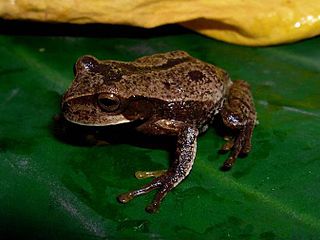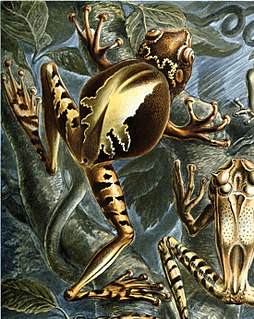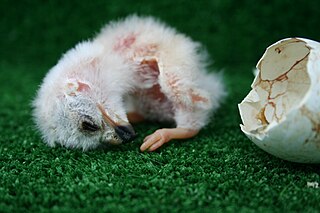
Ecuador, officially the Republic of Ecuador, is a country in northwestern South America, bordered by Colombia on the north, Peru on the east and south, and the Pacific Ocean on the west. Ecuador also includes the Galápagos Islands in the Pacific, about 1,000 kilometers (621 mi) west of the mainland. The capital is Quito.
Mammalian embryogenesis is the process of cell division and cellular differentiation during early prenatal development which leads to the development of a mammalian embryo.

Francisco Javier Eugenio de Santa Cruz y Espejo was a medical pioneer, writer and lawyer of mestizo origin in colonial Ecuador. Although he was a notable scientist and writer, he stands out as a polemicist who inspired the separatist movement in Quito. He is regarded as one of the most important figures in colonial Ecuador. He was Quito's first journalist and hygienist.

Nicole Marthe Le Douarin is a developmental biologist known for her studies of chimeras, which have led to critical insights regarding higher animal nervous and immune systems.
Gastrotheca andaquiensis, commonly known as the Andes marsupial frog, is a species of frog in the family Hemiphractidae. It is found on the Amazonian slopes of Andes in southern Colombia and Ecuador.

Gastrotheca argenteovirens is a species of frog in the family Hemiphractidae. It is endemic to Colombia and occurs in the Colombian Massif, Cordillera Central, and Cordillera Occidental in the Quindío, Tolima, Valle del Cauca, Cauca, and Nariño Departments. Common name Popayan marsupial frog has been coined for it.

The horned marsupial frog, originally named Nototrema cornutum Boulenger after the first describer George Albert Boulenger in 1898), is a species of frog in the family Hemiphractidae. It is an arboreal species found in Colombia, Costa Rica, Ecuador and Panama. Its natural habitats are tropical moist lowland forests and montane cloud forests. It is threatened by habitat loss.

Gastrotheca guentheri is a species of frog in the family Hemiphractidae. It is found in the Andes of Colombia and Ecuador. Gastrotheca guentheri is the only known frog with true teeth in both of its jaws, as indicated by the name of the genus it originally typified, Amphignathodon, described by George Albert Boulenger in 1882.

Gastrotheca ovifera is a species of frog in the family Hemiphractidae. It is endemic to northern Venezuela and is known from the Venezuelan Coastal Range, including Sierra de Aroa.

The Andean marsupial tree frog, also known as the Riobamba marsupial frog or Riobamba pouched frog, is a species of frog in the family Hemiphractidae. It is endemic to Ecuador. The species is confined to the Andes and the inter-Andean valleys, from Imbabura south to Chimborazo. They live in an altitude of 2,200-3,500 meters above sea-level. The Andean marsupial tree frog's habitat varies from the montane forests to the dry rocky hillsides, and from the agave plants to the corn fields. Once a common species, it is threatened by severe habitat loss.
Gastrotheca testudinea is a species of frog in the family Hemiphractidae. It has a widespread latitudinal range along the eastern (Amazonian) slopes of the Andes of Ecuador, Peru, and Bolivia.
The Ecuadorian Constitution requires that all children attend school until they achieve a “basic level of education,” which is estimated at nine school years.
Brigid L. M. Hogan FRS is a developmental biologist noted for her contributions to mammalian development, stem cell research and transgenic technology and techniques. She is currently a Professor in the Department of Cell Biology at Duke University, Born in the UK, she became an American citizen in 2000.

The Pontificia Universidad Católica del Ecuador (PUCE) is a Pontifical Catholic university founded in 1946 in Quito, Ecuador.

Claudio Daniel Stern FRSB, FMedSci, FRS is a Uruguayan biologist currently working at University College London (UCL).

Veronica Bonilla is a children's writer, illustrator, and graphic designer from Ecuador. She was born on 11 June 1962 in Quito D.M. and has published children's literature since 2012. She has 71 international book registers ISBN in several formats, in paper as well as in digital format. She publishes in both Spanish and English, and she also has produced audiobooks.
Olga Herrera-MacBryde (1937–2007) was an Ecuadorian-American botanist and international conservationist.

Animals make use of a variety of modes of reproduction to produce their young. Traditionally this variety was classified into three modes, oviparity, viviparity, and ovoviviparity.
Patricia A. Burrowes Gomez is an American herpetologist. She is a professor of biology at the University of Puerto Rico, Río Piedras Campus where she serves as principal investigator of the Amphibian Disease Ecology Lab. Burrowes specializes in amphibian population dynamics.
Katya Susana Romoleroux is an Ecuadorian botanist. In 2020, she was awarded the 29th Eugenio Espejo National Prize for her lifelong contribution to science in Ecuador.












